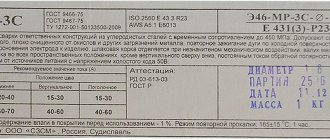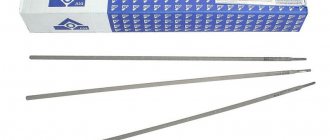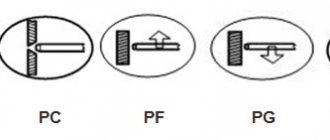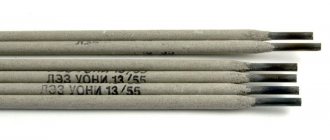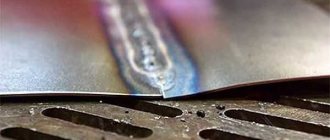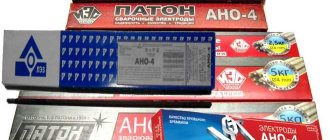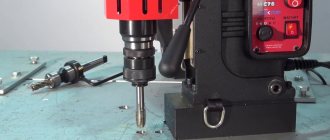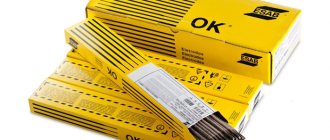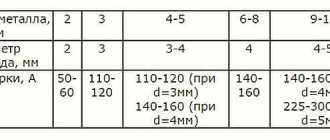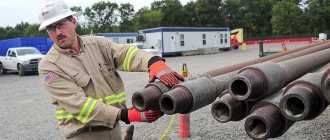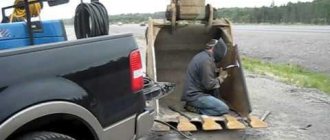The marking of welding electrodes (SE) contains information such as type, brand, diameter and other technical characteristics.
LE3ANO-21
An example of marking and its interpretation: E46-LEZAHO-21-⌀-UD E4Z 1(Z)-RTs1Z, where
● Type. Products of this type are used to work with metal structures made of steels whose tensile strength is 46 kgf/mm2.
● Brand. The main purpose of LEZANO-21 is to create permanent connections during the installation of ordinary and critical metal structures in cases where increased requirements are placed on connections.
● Purpose of SE. The U index indicates that SEs can be used to work with structural elements made of steel with a maximum tensile strength of up to 588 MPa (60 KGS/MM2).
● Coating thickness coefficient. The letter D indicates a coating of increased thickness.
● Type of meltable coating. According to the accepted marking system, this type of coating is marked with the letter E.
● Tensile strength. Index 4З is equal to 4З0 MPa (4З KГС/MM2).
● Relative elongation. The number 1 indicates a value of 20%.
● Min.t, at which the impact strength of the connecting seams is not lower than 34 J/CM2 (3.5 KGS M/CM2). The number Z corresponds to t -20C.
● Type of coverage. Coatings based on rutile and cellulose are marked PC.
● Possible positions during welding work. Number 1 indicates the ability to work in any position, including ceiling, sub-ceiling, semi-horizontal, semi-vertical.
● Welding current. Code 3 indicates that welding of structural elements with direct current of any polarity or alternating current from energy sources with an open circuit voltage of 50±3V.
ANO-21
Decoding of marking E46-AHO-21-2,5-UD E 4З0(З)-P-11 is carried out in the following order:
● SE type. Electrodes of this type are designed to work with metal structures made of steel with a tensile strength of 46 KGS/MM2.
● Brand. ANO -21.
● Rod thickness. In this case, the specified diameter is 2.5 mm.
● Purpose. The Y marking means that the products are intended to work with steels whose tensile strength is 588 MPa (60 KGS/MM2).
● Coating thickness coefficient. Index D means that the electrodes have a thick coating.
● The presence of a melting coating is indicated by the letter E.
● Strength to tensile loads. Code 4З corresponds to 4З0 MPA (44 KГС/MM2).
● Relative elongation. The number 0 indicates a relative elongation of 20%.
● Min temperature at which the impact strength of the weld is not lower than 34 J/CM2 (3.5 KGS M/CM2). Code Z indicates t -20C.
● Coating material. Rutile is used as a type P coating for solar cells.
● Acceptable spatial positions. The number 1 is indicated in cases where welding work can be carried out in any position.
● Welding current and open circuit voltage. The next unit is indicated in cases where welding is performed with alternating or direct current with a voltage of 50V.
MP-3 PLA3MA
Example of marking E46-MP-3 PLA3MA-⌀-UD E 4З0(З)-P26 and interpretation.
● Type and brand. Electrodes of this brand are intended for arc welding of metal structures in any position in space, with the exception of vertical.
● Scope of application. Electrodes designated by code U are used to work with alloys that have tensile strength. up to 588 MPa (60 KGS/MM).
● Coating thickness. Thick coating is marked with code D.
● Type of coverage. In accordance with the international classification system, fusible coatings are designated by the index E.
● Tensile strength equal to 430 MPa (44 KGS/MM2), indicated by the digital code 43.
● A relative elongation of 20% is marked with the number 0.
● The minimum t values at which the strength of the connecting seam is maintained is -20C and is designated by the index Z.
● A coating containing 48% rutile, 25% feldspar, 10% liquid glass, 10-13% each of magnesite and ferromanganese is designated by the letter P.
● The method of applying a weld, other than vertical, is indicated by the number 2.
● The number 6 indicates that work should be carried out at a voltage of 70V.
UOHI-13/55
The marking E50A-UONI-1Z/55-Z,0-UD E514(4)-B20 is deciphered as follows:
● Type and brand. SEs of this category are used to work with carbon and low-alloy alloys, whose tensile strength is 50 KGS/MM2. The letter A denotes increased ductility and impact strength of the connecting seam.
● Diameter. The thickness of the rod is 3.0 mm.
● Scope of application. Electrodes marked with the letter U are used to create permanent connections during the installation of metal structures made of alloys with a tensile strength of 588.3 MPa (60 KGS/MM2).
● Thickness and characteristics of the coating. A thick non-melting coating is designated by the indices D and E.
● Mechanical properties. The combination of numbers 51 indicates a tensile strength of 510 MPa (52 KGS/MM2), and the number 4 indicates a relative elongation of the metal of 20%. The minimum temperature at which the weld metal retains the specified strength is indicated by the number 4, which corresponds to -30C.
● Type of coverage. The main type of coating is marked with the letter B.
● Position in space. The number 2 in the SE marking corresponds to any position other than vertical.
● Welding current. The number 0 indicates the possibility of carrying out work with direct current of reverse polarity.
TsL-11
Decoding of the marking code E-08X20H9G2B-TsL-⌀-BD E-2005-B20:
● Type and brand. This type of electrodes is designed to work with parts and structures made of high-alloy steels.
● Scope of application. The index B denotes SEs used to connect elements of metal structures made of alloys with special properties.
● Coating characteristics. A thick coating of a melting type is marked DE.
● Methods for testing the resistance of connecting weld metal to intercrystalline corrosion. AM and AMU methods are designated by the number 2.
● The amount of fine delta ferrite in the weld metal. The number 5 corresponds to the ferrite phase content from 2% to 10%.
● Type of coverage. Marking B indicates that a base coat is being used.
● Welding current. The number 0 indicates that welding work is carried out with direct current of reverse polarity.
general information
Welding elements of the MP-3 brand are suitable for joining workpieces made of carbon and low-carbon steels. They can be welded in close contact or leave a small gap. In the latter case, experts recommend choosing the welding mode very carefully and using less than the rated current to avoid the formation of defects or cracks in the metal.
Additive materials produced under this brand are advantageous in that during their use a minimal amount of substances is released, so there is no doubt about their safety. They are indispensable for welding carried out in particularly difficult conditions, since they are the least demanding on the cleanliness of the surface, which may have rust stains or moisture, but this does not greatly affect the quality of welding.
Welding work is carried out using conventional transformers that maintain a minimum voltage of 50 V. MP-3 welding material can also be used for mounting parts of medium or large thickness. The metal can be easily welded throughout the entire recess, ensuring high strength of the joint created. Based on the technological conditions of welding work, when working with these electrodes, it is not necessary to create a large arc to obtain a temperature sufficient to set the metal with the electrode .
As part of the preparatory stage, the electrodes must be dried and calcined, which only has a positive effect on their working properties. Electrodes of this brand can be used in combination with transformers that support operation with direct and alternating current. Filler material can be worked in any position due to the fact that, regardless of the operating conditions, they can provide a high quality connection.
At the end of welding, it is necessary to perform the final operation - remove slag from the metal. This is done very easily, so the quality of the connection remains consistently high. The coating of the electrode directly affects its inherent advantages. The welding material has a special chemical composition, thanks to which it is possible to maintain a stable arc when working in any plane. Due to the stability of the arc, the quality of welding is consistently high, regardless of the influence of extraneous factors.
This is interesting: Metric thread: table of sizes and parameters according to GOST
Storage conditions and calcination
Model MP-3 electrodes must be stored under certain conditions. The room must be heated with a temperature T>15℃ and air humidity not exceeding 40%. Packages with these products should be placed on pallets or racks. This will prevent unwanted contact with load-bearing walls and floors.
When welding work is carried out in an open space, measures must be taken to prevent precipitation from entering the boxes with electrodes. Excessive inventories of these products should not be created. They should be enough for no more than 2 days of work. And it is necessary to replenish reserves as electrodes are consumed.
Subject to the above conditions, there is no need to ignite these products before use. In this case, the rutile coating does not lose its excellent performance characteristics. But if the MP-3 electrodes did come into contact with moisture, they must be calcined at a temperature of 100℃≤T≤150℃ for one to two hours.
Decryption, how to decrypt
To understand what kind of work you should use MP-3 electrodes for, you need to familiarize yourself with their markings. It is important to understand that some components of the label vary, more on this below. This is what the marking of the MP-3 electrodes looks like (see photo above) - E46-MR-3-Ø-UD2 E 430(3)-P26, where
- E46 – type of electrode, in this case – for welding carbon and low-alloy steels with tensile strength up to 46 kgf/sq.mm.;
- MP-3 – electrode brand;
- Ø – diameter of the electrode, the most popular rods are 4.0 mm;
- UD - materials for welding of which the rod (U) and coating thickness (D) are intended, in this case - for welding carbon and low-alloy steels and with a thick coating. There are also MP-3 rods with a thick coating of the second group - UD2;
- E – international designation of consumable coated electrodes;
- 43 – tensile strength, in this case – 430 MPa (44 kgf/sq.mm.);
- 0 – relative elongation, 0 = less than 20%;
- (3) – the minimum temperature at which the impact strength of the seam is at least 34 J/sq.cm, 3 = minus 20 degrees;
- P – type of coating, in this case – rutile; some sources indicate RB - rutile-basic;
- 2 – spatial positions of the rod at which welding is carried out, in this case – all positions, with the exception of the vertical “top to bottom”;
- 6 – welding current and no-load voltage, 6 – this is welding with alternating and direct current of reverse polarity, the running voltage is about 70 V (not less than 50, 60-80).
Features of use
When working with MP 3, it is permissible to use both alternating and direct current . The welding source must provide an open circuit voltage of 50 volts. When operating with direct current, the connection polarity is reversed. In this case, the positive contact is connected to the holder, and the negative contact to the workpiece.
Electrodes have the following advantages:
- easy ignition and stable combustion of the electric arc;
- making a durable, well-welded seam with specified geometric parameters;
- Spattering of melt droplets is minimized;
- the fragile slag crust that forms above the suture material is easily and quickly removed during stripping;
- facilitated re-ignition of the electric arc after a break in the conduction of the electrode;
- high welding productivity.
Despite the fact that the product is optimized for difficult working conditions, in no case should you neglect the preparation of the seam area for connection. The better the workpiece is cleaned and degreased, the stronger and more durable the seam will be .
The suture material has an impact strength of 80 J/cm2, allows bending up to 150°, and the relative elongation is 18%.
The weld material has physical and mechanical parameters close to the characteristics of the metal of the part itself. Therefore, the seam does not create additional mechanical stresses that weaken the entire structure and reduce its strength and reliability.
GOST and other requirements
Electrodes of the MP-3 brand are produced in accordance with the requirements of state standards (GOST 9467/9466). According to the standards, the filler material of the consumable welding element is classified as type E46. Similar rods are used when welding low-alloy low-carbon steels with a carbon content of 0.25%.
Powdered rutile concentrate is applied to a metal core. The active substance is titanium dioxide. The coating consists of a carbonate or aluminosilicate mixture, which increases the viscosity of the workpiece. This reduces the occurrence of cracks and deformations in the resulting seam.
The electrode core material is low-carbon wire of the Sv-08 configuration, manufactured by cold rolling. The diameter of the product is from 2 to 6 mm. The thickness of the welded workpieces is 3-20 mm. Temporary mechanical tensile strength reaches 500 MPa.
Which welding electrodes are best to buy?
The correct choice of rod depends on the technical characteristics of the tool, the physical characteristics of the metal and the type of welding.
Electrodes are divided into two groups:
- Melting;
- Non-melting.
The former are made from welding wire and are suitable for processing non-ferrous metals of small and medium thickness, as well as steels and alloys.
The basis for non-consumable electrodes is tungsten, graphite or carbon. Such rods are used in argon arc welding and processing of aluminum, copper, magnesium, bronze, and titanium. Often, when working with non-consumable electrodes, not only argon or helium, but also nitrogen or hydrogen are used.
An important selection criterion is also the diameter of the electrode. The permissible thickness of the metal being processed depends on it.
For small household needs, rods with a diameter of up to 2.5 mm will be sufficient, allowing welding of elements with a thickness of about 4 millimeters.
In turn, the required electrode diameter and maximum metal thickness are affected by the current strength of the welding tool.
Devices for professional use have a value of this characteristic of at least 200 A. This is enough for high-quality welding of metal with a thickness of more than 15 mm with an electrode with a diameter of 5 mm.
Advice! Despite their unlimited shelf life, welding electrodes are extremely demanding on storage conditions. It is important to prevent mechanical damage, contamination and high levels of humidity in the areas where the rods are kept. GOST 9466-75 provides for a storage temperature of electrodes not lower than +15°C.
Recommendations: 11 best semi-automatic welding machines
15 best welding inverters
8 best welding transformers
Symbol for MR electrodes - an example of a complete decoding
- E - electrodes for manual arc welding;
- 46 — temporary tensile strength — no more than 46 kgf/mm2;
- MP-3 - brand;
- LUX is the commercial name under which the electrode is produced by a certain manufacturer;
- Ø—diameter;
- U - for welding carbon and low-alloy steels;
- D - with a thick coating;
- 43 - temporary tensile strength in the state after welding at normal temperature;
- 0 — relative elongation less than 18%;
- ->(3) - impact strength of the deposited metal αН45 (at a temperature of - 20°C), not less than 3.5 kgf•m/cm2;
- RC - rutile-cellulose coating;
- 11 - welding in all spatial positions except vertical from top to bottom with alternating and direct current.
Best Cellulose Coated Welding Electrodes
A feature of such rods is the presence of a large number of organic elements in the composition.
When using electrodes with cellulose coating, a high speed of work is achieved, easy separation of slag, and gas protection of the material is created.
They are used for welding main pipelines, processing carbon and low-alloy steels.
ESAB Pipeweld 6010 Plus
4.9
★★★★★
editorial assessment
94%
buyers recommend this product
The main advantages of these rods include ease of control of the welding arc and a large penetration depth. The quality of the seam does not depend on the chosen spatial position, so working with rods is extremely convenient.
The line of electrodes is represented by samples of various diameters: 2.5, 3.2, 4 and 5 mm. This allows you to successfully process metal with a thickness of more than 10 millimeters. The rods do not require calcination before starting work.
Advantages:
- stable combustion;
- easy slag separation;
- smooth seam;
- economical consumption.
Flaws:
- don't like dampness.
ESAB Pipeweld 6010 Plus are suitable for domestic or professional use. A wide range of permissible diameters allows processing metals of various thicknesses.
Craton J422
4.9
★★★★★
editorial assessment
91%
buyers recommend this product
The electrodes are distinguished by the high quality of the welding seam produced. They have a low tendency to form pores and cracks, as well as high strength - 420 MPa. A high-quality coating is not subject to shedding even when deformed.
Rods of various diameters are available to the buyer, including 2.5, 3.2 and 4 mm. This allows you to process metal with a thickness of 2 to 6 millimeters. Work can be carried out in any spatial position and under different temperature conditions.
Advantages:
- ease of slag separation;
- low metal losses;
- high-quality seam;
- low price.
Flaws:
- difficulty of secondary ignition.
Kraton J422 are used for welding low alloy steels. Electrodes will be especially useful when processing root seams of pipelines or when used in hard-to-reach places.
Specifications
If we consider the technical characteristics of MP-3 electrodes, they will depend not only on the size of the material, but also on its chemical composition.
| Chemical composition, % | ||||
| Carbon | Silicon | Manganese | Sulfur | Phosphorus |
| 0,1 | 0,2 | 0,5–0,8 | 0,04 | 0,045 |
But for specialists who select a brand for the conditions in which already welded parts will be used, they consider the mechanical properties. This helps you make an accurate choice based on price-quality ratio among the available options. The mechanical properties of the deposited metal on a weld in this grade are as follows:
| Test temperature, degrees Celsius | Tensile strength, N/mm2 | Relative extension, % | Impact strength, J/cm2 | KCV>34 J/cm2 at temperature, degrees Celsius |
| + 20 | 450 | 18 | 78 | – 20 |
| Surfacing productivity, g/min | Relative yield of deposited metal, % | Material consumption per 1 kg of weld weld, kg | ||
| 23,5 | 90 | 1,7 | ||
Sizes and range
| Electrode diameter, mm | Electrode length, m |
| 2 | 0,3 |
| 2,5 | 0,3 |
| 3 | 0,35 |
| 4 | 0,45 |
| 5 | 0,45 |
Features of surfacing
Having examined the characteristics of the MP-3 electrodes, indicate which welding current corresponds to the selected diameter. After all, this will help to avoid troubles with consumables sticking, as well as scorching of the workpiece, which is unlikely if the thickness is large, but still possible. Here are the most common options for all positions used:
| Electrode diameter, mm | Current strength in lower position, A | Current strength in vertical position, A | Current strength in ceiling position, A |
| 3 | 100…140 | 80…100 | 80…110 |
| 4 | 160…220 | 140…180 | 140…180 |
| 5 | 180…260 | 160…200 | – |
Designation and explanation
MP-3 blue electrodes in their abbreviation contain the designation that “M” is a material with a thin rutile-ilmenite coating, which “P” meets high requirements for the seam. “3” means that this is the third model of the plant producing these electrodes.
Welding electrodes MP-3 with a diameter of 3 mm
Manufacturers:
- Standard;
- Resanta;
- Vistek;
- EkonPlus;
- Era;
- Monolith.
This is interesting: Electrodes E42 - characteristics, operating features, cost
Electrodes E46a
For welding steel products, when increased demands are placed on the weld metal regarding impact strength and relative elongation, electrodes of the E46a grade are used. They are consumables of this type, with improved properties. They can be used when welding structures made of thick sheets, in positions that are inconvenient for the welder, and when installing on construction sites.
This type includes a number of different brands. Electrode grade E46a is used for welding steel products with high ductility requirements. Example notation:
The number 3.0 indicates the diameter of the electrode of this brand. The difference from E46 lies in the plasticity indicators, which are higher. They are preferred when welding structures are to be operated at low temperatures and mechanical loads of variable significance. An example is refrigeration units.
Design and material of manufacture
For the production of MP-3 electrodes, wire of different sections can be used.
The manufacturing technology requires applying a special rutile coating to each product. The filler material may differ in length, which can be 300–450 mm, and in outer diameter, its value varies in the range of 2–6 mm. This design allows the use of welding material MP-3 for welding work on unprepared surfaces that have dirt and traces of rust. During storage, it is necessary to maintain optimal humidity in the room. For rutile coating, it should not exceed 1.5%, otherwise, before use, the electrodes must be calcined for at least 60 minutes at a temperature of +180 degrees.
During welding, it is necessary to focus on the nominal characteristics that a high-quality weld . Subject to the requirements of the working process technology, the connection must have a tensile strength of 46 kgf/mm². The limit of weld deposition coefficient is 8.5 g/A*h. To determine the required number of electrodes, the mass of the deposit during welding must be taken into account. For MP-3 electrodes this parameter is 1.7 kg/hour.
To obtain reliable welded joints, it is necessary not only to have welding skills, but also to use suitable consumables. Among the electrodes that have proven themselves well, it is especially worth highlighting the electrodes of the MP-3 brand. They have a lot of useful properties, among which it is especially worth noting that they are undemanding to the quality of the surfaces of the metals being welded.
This filler material can be used for welding joints of parts containing moisture, dirt and oxides on the surface. Moreover, the end result does not suffer from this in any way.
These electrodes also have other positive properties that are well known to experienced welders. However, it must be taken into account that MP-3 electrodes are a highly specialized filler material that is suitable for welding only low-alloy and carbon steels with a carbon content of 0.25%. Therefore, it is necessary to know the specific application of these welding elements in order to comply with all the requirements of the welding process. This is especially true for the magnitude of the operating current, on which the quality of the weld largely depends.
Features of electrodes of the MP-3 and MP-3c brands
Products of both brands provide the ability to weld with short tacks, as well as perform it with a long arc. Due to their technical characteristics, there is no need for preliminary preparation of the metal to be welded. On its surface the presence of:
- traces of corrosion;
- oxide residues;
- slight dirt;
- moisture.
Electrodes of the MP-3 and MP-3c brands can be used if it is necessary to perform welding work along an existing gap. The amount of current during their course should be as minimal as possible, otherwise pores will begin to form in the seam being created.
In addition to these electrodes, consumables of the MP-3m brand are actively used today. They differ in the type of coating: they have rutile-ilmenite. MP-3c electrodes contain a coating saturated with additional ionizing impurities. The characteristics of electrodes of all three brands - MP-3, MP-3m and MP-3c - are largely similar and almost completely identical.
The coating of the latest products ensures easy ignition of the welding arc. This feature makes it possible to use low-power current sources for operation. MP-3c electrodes are more environmentally friendly. When they are welded, harmful substances are released into the environment in a volume that is smaller compared to MP-3 (MP-3 has 1.25 grams of manganese, and MP-3c has 2 times less - 0.6 grams). But the most compelling argument in favor of choosing the latter electrodes is the possibility of obtaining a better-quality weld. As a result, the formed connection will have better performance properties.
Peculiarities
The filler material of this brand can be used to connect structures both long and using short tacks. With their help, it is possible to perform metal connections without preliminary preparation, which may have:
- wet surface;
- traces of oxides and contaminants;
- signs of rust.
Welding elements MP-3 are also suitable for connecting elements along gaps, but when using a minimum current. Otherwise, pores may appear in the seam. The presence of the letter “m” (MR-3m) in the marking of welding elements indicates the presence of a rutile-ilmenite coating, and the letter “c” (MR-3s) indicates the use by the manufacturer of a rutile coating containing special ionizing additives.
If we compare these two types of electrodes in terms of characteristics, then these are the same MP-3 electrodes.
The MP-3 welding material simplifies the arc ignition process due to the presence of special additives in the coating when using low-power welding machines with a voltage of about 50 V. In addition, they are more preferable than conventional MP-3 electrodes due to higher sanitary and hygienic indicators . Welding carried out using such elements is accompanied by the release of no more than 0.6 g of manganese. When using conventional MP-3 electrodes, 1.25 g of the substance is released.
In addition, MP-3 elements allow for more uniform seams, which has a positive effect on the mechanical characteristics of the joint.
How are they different from MP-3?
Electrodes MP 3 and MP 3C are very similar. Their composition and characteristics are almost identical, with the exception of one feature. The MP 3C brand contains a number of additives, thanks to which the arc is easier to ignite and burns more stably when using a low-power household welding inverter. Also, this brand emits much less manganese during operation than MP 3. The seams are more uniform and easier to form.
From this we can conclude that the MP 3C brand is more likely intended for amateur welding at home, and MP 3 is more universal. They can be used both at home and in professional activities.
Characteristics and properties
The technical parameters of the electrodes include the consumption for surfacing a given amount of metal (weld). To process 1 kg of material, 1.7 kg of MP-3 type rods will be required. The result is a productivity of 1.7 kg/h and a working coefficient of 8.5 g/Ah.
These electrodes are characterized by high operating speed and allow welding with full contact with the surface or with a short arc at a distance. Products of the LEZ MR type are produced on Losiny Ostrov, in the Moscow region, Kostroma region, and Syzran. The closest analogues of foreign production are manufactured in Cleveland (USA).
Weight and diameter
The setting of the welding current and the spatial position of the seam being formed depend on the size of the electrode. The indicators are as follows:
| Diameter, mm | Vertical seam, A | Bottom seam, A | Ceiling seam, A |
| 3,0 | Up to 110 | 100-140 | Up to 120 |
| 4,0 | 150-180 | Up to 220 | 140-180 |
| 5,0 | Up to 200 | Up to 260 | |
| 6,0 | 300-360 |
The weight of the MP-3 electrode and its length also depend on the diameter. Parameters vary from 30 to 92 g and from 350 to 450 mm, respectively.
Surfacing composition
Welding is carried out using the tear-off weld method, lighting an arc at the left edge, carrying out wiring from left to right, then in the opposite direction. The operation must be performed quickly so that the seam does not have time to cool. The process produces a lot of slag, which completely fills the bath and the gap across its entire width. The temperature of the coating is significantly higher than that of the steel being processed.
The material is easily separated after cooling during multi-pass wiring.
The spattering of the metal is weak, the slag lays down in a neat, even layer and peels off easily. When working with titanium dioxide, the residues fall into the melting bath, forming specific shells. Surfacing in mass fractions consists of:
- manganese (0.08-0.12);
- silicon (0.07-0.2);
- carbon (up to 0.8);
- phosphorus (up to 0.04);
- sulfur (up to 0.04).
Mechanical properties of the seam
The difference between the use of MP-3 electrodes and analogues is the possibility of welding uncleaned edges of workpieces. Oxides, scale, dust, moisture do not deteriorate the quality of the seam. During operation, contaminants evaporate and mix with the slag. This results in a seam with good technological parameters:
- impact viscosity - up to 8 kgf/sq.cm;
- breaking resistance - about 46 kgf/sq.mm;
- elongation rate - up to 20%.
Quantity per pack
Manufacturers package the electrodes in question in packs weighing 1.0/2.5/5.0 kg. The length and weight of the rod depend on the diameter of the elements, as well as their number in the package. The table provides information on the capacity of electrodes in a 1-kg pack, taking into account the specified parameters.
| Diameter, mm | Weight, g | Rod length, mm | Package quantity, 1.0 kg (pcs.) |
| 3,0 | 32,0 | 350 | 39,0 |
| 4,0 | 62,0 | 450 | 16,0 |
| 5,0 | 92,0 | 450 | 11,0 |
Voltage and device settings
The characteristics of MP-3 electrodes involve connecting reverse polarity if work is carried out on direct current. With alternating voltage, the polarity of the connection does not matter. You can cook with a short, long or intermittent arc. Damp rods are calcined for 45-60 minutes at a temperature of 180 °C. The current is selected taking into account the diameter of the element. For products with a cross section of 3 mm, 140 A is enough; modifications with a thickness of 5-6 mm are used with a current strength of 300 A. Work is performed by holding the rod at an angle of 45°.
Features of MP-3 brand products
Electrodes of the MP-3 brand have the following technological characteristics:
- easy ignition of the welding arc. It is characterized by stable combustion;
- forming a weld seam is not particularly difficult even for a novice welder;
- the degree of spattering of molten metal is minimal;
- the crust of frozen slag on the surface of the created seam is easily separated;
- re-ignition of the electric arc does not cause difficulties;
- high level of productivity of work related to welding, without compromising the quality of the formed seam.
Setting the welding current requires a special approach. The value of this parameter (designation Ist.) is determined by two factors: the spatial location of the seam being formed and the diameter of the electrode (designation De.). So, for products with
- De.= 6.0 mm at a current varying within 300.0 A≤Ist.≤360.0 A, exclusively lower seams are performed;
- De.= 5.0 mm: the lower seams are formed at a current of 180.0 A≤Ist.≤260 A; vertical seams at current 160.0 A≤Ist.≤200.0 A;
- De.= 4.0 mm: the formation of ceiling seams is carried out at a current of 140.0 A≤Ist.≤180.0 A; lower ones - at a current of 160.0 A≤Ist.≤220.0 A; vertical seams - 140.0 A≤Ist.≤180.0 A;
- De.= 3.0 mm: ceiling seams are made at a current of 100.0 A≤Ist.≤120.0 A; bottom seams at current 100.0 A≤Ist.≤140.0 A; vertical - 90.0 A≤Ist.≤110.0 A;
Important characteristics of electrodes include their total weight required to deposit a certain volume of metal in the weld being formed. For example, for products with a diameter of D = 4.0 mm of the MP-3 brand, these figures look like this: to surfacing 1 kilogram of metal, 1.7 kilograms of such electrodes are required. The work productivity is ensured at the level of 1.7 kilograms per hour with a deposition rate of 8.50 grams/Ah. You should know that the deposition rate is usually less than this indicator of the electrode melting process. This phenomenon is caused by metal loss during welding work.
Diameter
What is the diameter (in, d, Ø) of all MP-3 electrodes, length, weight of the pack (kg.)
Manufacturers produce electrodes with a diameter of 2.5; 3.0; 4.0; 5.0 and 6.0 mm. The first and last types are used less frequently. Depending on the diameter, the length and weight of the rod varies, as well as their number in the pack. The indicators are presented in the table.
| Diameter, mm. | Weight, gr. | Length, mm. | Number of electrodes in 1 kg, pcs. |
| 3 | 30-32 | 350 | 39 |
| 4 | 60-62 | 450 | 16 |
| 5 | 92 | 450 | 11 |
Manufacturers offer the following format of packs with electrodes: 1.0; 2.5; 5.0 kg.
For example, below we show a 1-kilogram pack of the manufacturer Resant.
Characteristics
In construction stores you can easily find LEZ MR-3S electrodes, manufactured by the well-established Losinoostrovsky Electrode Plant. They comply with the requirements of GOST 9466.
LEZ MR-ZS electrodes have a rutile coating, which consists mainly of titanium dioxide, which is the mineral rutile. In addition, the coating may contain other elements that increase the toughness of the deposited metal. This reduces the likelihood of defects such as pores and cracks appearing in the weld. Rutile coating ensures rapid ignition of the arc, both primary and secondary.
In this case, the weld pool is reliably protected from the harmful effects of oxygen and nitrogen. LEZ electrodes MR-ZS have technical characteristics:
- An electrode with a rutile coating is classified as a consumable element.
- The internal rods are made of Sv-08 wire.
- The main alloying elements included in the rod are carbon and silicon. It contains small amounts of manganese, sulfur and phosphorus.
- Welding can be carried out in all positions, with the exception of moving the electrode from top to bottom.
- Possibility of working with different types of current.
- Long arc welding is acceptable.
- The spray coefficient is in the range of 9-13 percent.
- Good meltability of the edges of the metal being welded.
- Electrodes can weld parts with a thickness of 3 to 20 millimeters.
The diameters of the electrodes are in the range of 3-6 millimeters. As the cross-sectional size increases, the length of the electrodes increases.
The welding current is set depending on the diameters of the electrodes used and the spatial position during the welding process. So, for example, if MR-ZS 3mm electrodes are used, then in a vertical position a current of 90-110 Amperes is set. In lower and ceiling positions, these values can be increased.
Welding electrodes MR-ZS 3mm have different packaging. For example, if you need to use a large number of consumables, it makes sense to purchase welding electrodes MR-ZS 3mm 5kg. The number of electrodes that fits in one package depends on the weight. The weight of one electrode with a diameter of 3 millimeters is 30 grams. If you purchase a pack whose weight is two and a half kilograms, then it will contain 86 electrodes with a cross section of three millimeters. A five-kilogram package will hold 54 electrodes with a diameter of 5 millimeters.
Advantages and disadvantages
The advantages of MP-3 electrodes include:
- rapid formation of a stable arc;
- smooth, reliable seam;
- high connection strength;
- safety, no release of harmful substances;
- easy removal of slag;
- small range of metal spattering;
- high productivity;
- ease of operation.
Disadvantages include high price and intensive consumption of welding material.
MR electrodes - technical characteristics
MP-3 electrodes are used for welding with direct (reverse polarity) or alternating current, which provides an open-circuit voltage of at least 50 Volts. Under normal temperature conditions, the metal of the resulting compound exhibits the following characteristics:
- The mechanical tensile strength indicator is no more than 46 kgf/mm2;
- Relative extension — 18%;
- Impact strength - 8 kgf∙m/cm2.
- The consumption of MP-3 electrodes per 1 kg of metal is about 1.7 kg of MP-3.
- The weld deposition rate limit is 8.5 g/A*h.
- Metal spatter coefficient during welding — 9-13%;
- Open circuit voltage - 60-80 V.
- Welding in all spatial positions, except vertical from top to bottom.
| Diameter | Position | Current strength |
| 3 mm | vertical | 90−110 A |
| lower | 100−140 A | |
| ceiling | 100−120 A | |
| 4 mm | vertical | 140−180 A |
| lower | 160−220 A | |
| ceiling | 140−180 A | |
| 5 mm | vertical | 160−200 A |
| lower | 180−260 A | |
| 6 mm | only the bottom | 300−360 A |
The best welding electrodes with basic coating
Such rods are characterized by low oxidizing ability, and the resulting welding seam has a low content of hydrogen, oxygen, sulfur and phosphorus impurities. Therefore, it has good crack resistance.
Similar electrodes are used for welding hardening, deoxidized steels and multilayer structures.
ESAB UONII 13/55
4.9
★★★★★
editorial assessment
92%
buyers recommend this product
See review▶
Electrodes can be used for welding in almost all spatial positions. The deposited metal is resistant to crystallization cracks and is almost completely free of hydrogen.
The rods have a diameter of 2 to 5 millimeters, which allows processing materials up to 8 mm thick.
The permissible calcination temperature before work is 350-400°C. To avoid the formation of pores, welding should be carried out with direct current using a short arc.
Advantages:
- wide range of sizes;
- welding from any position;
- seam strength;
- economical consumption.
Flaws:
- sticking at high current.
ESAB UONII 13/55 are designed for welding low-carbon or low-alloy steel. The ease of operation in any position and the reliability of the resulting seam allow the rods to be used effectively in cramped conditions.
Lincoln Electric SSSI 13/55
4.9
★★★★★
editorial assessment
90%
buyers recommend this product
The main features of these consumables include low cost and increased service life.
Electrodes can be used when working with materials at sub-zero temperatures and high humidity levels and do not require special storage conditions.
The diameter of the rods is 4 millimeters, the maximum permissible welding current is 160 Amps. Their use is effective in any spatial position, which ensures ease of work with various structural elements.
Advantages:
- high impact strength;
- work at temperatures down to -40 °C;
- minimal splashing;
- stable arc burning.
Flaws:
- require long-term calcination.
Lincoln Electric UONI 13/55 is an excellent choice for arc welding of reinforcing, carbon and alloy steels. Recommended for work in difficult conditions or prolonged use in frosty weather.
PlasmaTec Monolith TsCh-4
4.8
★★★★★
editorial assessment
88%
buyers recommend this product
A special feature of the electrodes is the ability to work in unfavorable conditions. During welding, a gas bubble appears around the arc, preventing water or dust from entering the joint.
The diameter of the rods is 3 mm. They are characterized by arc stability, low spatter, and ease of both initial and re-ignition. This ensures high weld quality and rapid slag separation.
Advantages:
- protection of the welding zone;
- straight seam;
- economical consumption;
- do not require calcination.
Flaws:
- not intended for vertical welding.
PlasmaTec Monolith TsCh-4 is used for professional welding of thin sheet metal. An excellent choice for tank or pipeline work.
Kobelco LB-52U
4.8
★★★★★
editorial assessment
86%
buyers recommend this product
They are distinguished by high arc stabilization and large depth of material penetration. Due to the low hydrogen content, the resulting weld is resistant to cracking and has high impact strength.
The diameter of the electrodes is 3 mm, length 40 centimeters. The rods are used for welding metals corresponding to strength classes up to K54, K55-K60. Material processing can be carried out using both direct and alternating current.
Advantages:
- reliable connection;
- fast calcination;
- deep metal penetration;
- ease of slag separation.
Flaws:
- difficulty in re-ignition.
Kobelco LB-52U is suitable for reinforcing the back side of a weld. The rod will be useful for internal processing of pipelines or tanks.
READ ALSO
6 Best Welding Generators
Colors: blue, red (brown), green
The color of the electrodes depends on the type of coating. MP-3 rods most often have a rutile coating, which is sometimes red in color. It is also important to know that the shade depends on the manufacturer . Thus, welders have the opportunity to buy electrodes with green, blue, and gray coating colors.
Flaws
- The connection obtained by welding is characterized by high strength.
- The arc is distinguished by easy ignition and combustion stability, especially at low current strength.
- Re-ignition is achieved without difficulty.
- The resulting seam has no joints, it is even and has a good presentation.
- There are no pronounced transition zones between the weld metal and the part.
- Thanks to the rutile type of coating, the seam is reliably protected from slag and oxidation.
- The electrode is characterized by very little metal spattering.
- The work is characterized by high productivity.
- MP-3 is equally suitable for both welding and tack welding.
There are relatively few disadvantages to electrodes of this brand, and some of them are quite conventional.
- Relatively high price - the cost of this consumable is slightly higher than many other electrodes.
- The impossibility of welding vertically from top to bottom - however, many other brands cannot “boast” of this.
- Not the lowest material consumption - 1.7 kg per 1 kg of seam (MR-3R has slightly less - 1.62 kg).
- During the welding process, the electrode must be held at an acute angle relative to the surface being made. If you weld at a right angle, a large amount of slag will inevitably be released, which will penetrate into the seam.
- It is extremely important to set the required current strength - otherwise there is a risk of pores forming in the weld metal.
And one more feature - intermittent sutures must be applied quickly enough, which requires certain skills. However, even beginners can master this technique in a short time, without much experience or special education.
Application area
The material obtained during welding has a reduced tensile strength, so the use of this type of electrode for critical structures is not recommended. However, their area of application is quite wide. The characteristics of the electrodes make it possible to fully reveal their advantages when welding products made from low-alloy steels.
They can successfully weld carbon steels. However, there are limitations in that these electrodes cannot be used to connect products made of stainless steel, cast iron and non-ferrous metals.
Professional welders often choose this type of electrode due to its high performance. For everyday use, other positive qualities are valued. Such consumables are used when installing fences in summer cottages, constructing garages, and arranging greenhouses.
Technological features
Manufacturers of MP-3 electrodes point out the importance of observing their storage conditions. The room must be dry and heated, the ambient temperature should not be lower than +15 degrees. The rods should be protected from moisture, contamination, and mechanical influences.
If liquid gets on the electrodes, they must be calcined at a temperature of +180 degrees for one hour before use.
Welding can be performed with a long arc, but welding with short tack welding is also possible, the so-called “tear-off” method.
Manufacturers and brands
Buyers have the opportunity to purchase MP-3 electrodes of various brands, Russian and foreign manufacturers. When purchasing, you should choose rods from proven and reliable companies. Large companies that value their reputation produce high-quality rods that have the appropriate certificates, passports and other documents.
The greatest attention should be paid to the following class=”aligncenter” width=”644″ height=”362″[/img]
- LEZ (Losinoostrovsky Electrode Plant);
- Resanta;
- HOBEX;
- SZSM;
- Lincoln Electric (Lincoln);
- Spetselectrode (Moscow);
- ESAB (Esab);
- Tantalum;
- Arsenal (Ars);
- Prestige;
- Luxury;
- Premium
Decent analogues in comparison
In addition to MP-3 electrodes, modifications such as ANO and UONI are popular among welders. They are often compared with each other to choose the best option, but this is not entirely correct. These rods differ not only in coating, but also in structure. The main difference lies in the composition and method of coating.
SSSI electrodes
Unlike the MP-3 brand, UONI rods have a base coating rather than rutile. They are designed to operate from DC devices with reverse polarity. Before welding the SSSI, the surface must be thoroughly cleaned. Spraying is also sensitive to moisture.
Brief characteristics of this brand:
- surfacing coefficient - 9.5 g/Ah;
- consumption per 1 kg of metal - 1.7 kg;
- productivity - 1.4 kg/h;
- safety factor - 540 MPa;
- fluidity - up to 420 MPa;
- relative elongation - up to 22%.
ANO electrodes
ANO rods are distinguished by the variety of rods and specific parameters. It is inappropriate to compare them directly with the MP-3 brand. This is due to the fact that these elements are designed for welding metal up to 4 mm and are not suitable where MR modifications are needed.
Short description:
| Diameter, mm | Length, mm | Package capacity 1 kg (pcs.) | Limit operating current, A |
| 2,0 | 300 | 95 | 100 |
| 3,0 | 350 | 40 | 140 |
| 4,0 | 350 | 40 | 180 |
